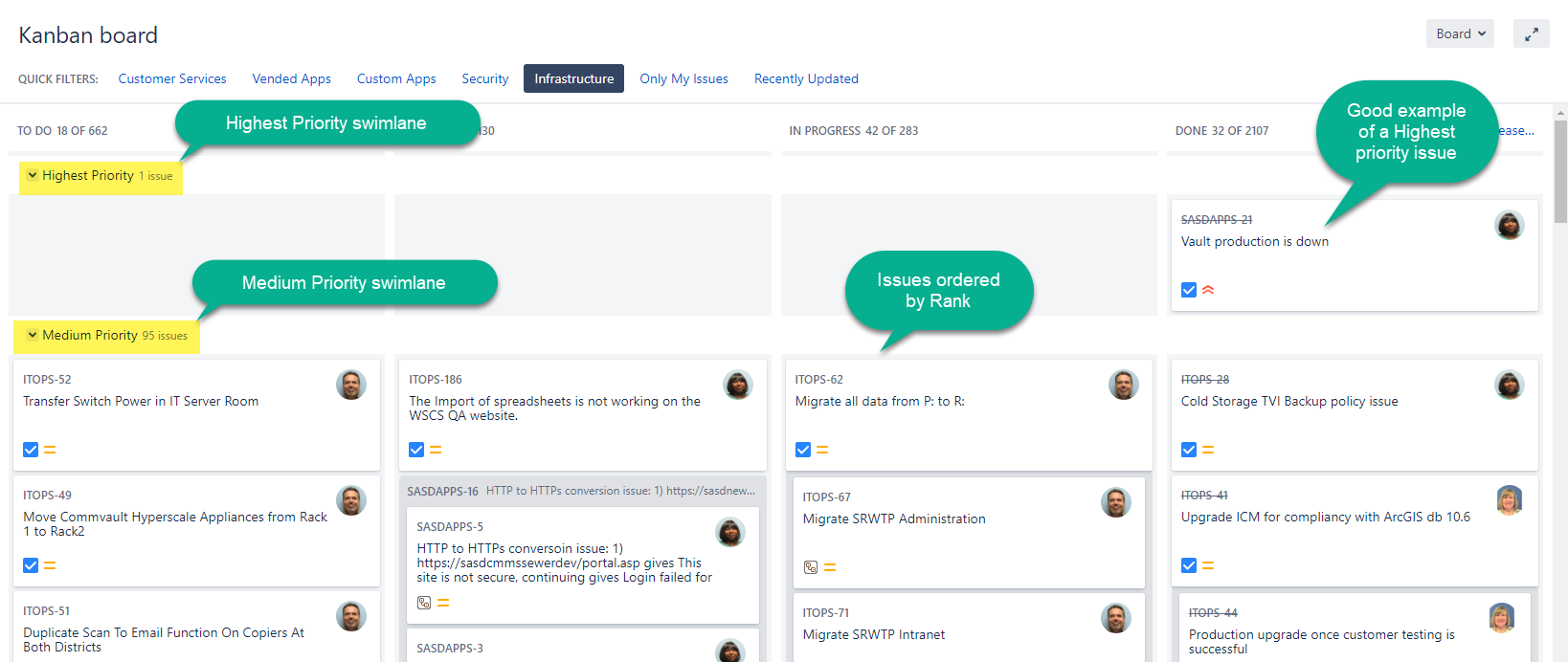Jira Issue Priority and Rank
It is important that we all have the same understanding of the use of Priority and Rank in Jira as they prescribe the order in which we work on issues.
Priority
There are five priority options in Jira. Below are the priorities, along with examples of their intended usage and other expectations.
Highest
- Examples
- A high profile production system is down
- A bug is causing the inability to use or corruption of data in a critical system
- A production server is down unexpectedly
- A very high security risk
- A large number of users are unable to work
- Expectations
- Highest priority issues should be addressed ahead of all High and lower priority issues
- Working overtime and through lunch is not uncommon for highest priority issues
- There should be a non-stop effort to resolve these issues
- Very few issues meet the criteria to be classified as the Highest priority
High
- Examples
- A less-critical production system is down
- A bug is causing the inability to use or corruption of data in a less-critical system
- A dev/test server is down unexpectedly
- A high security risk
- A small number of workers are unable to work
- Expectations
- High priority issues should be addressed ahead of all Medium and lower priority issues
- Working overtime and through lunch is probably not required for high priority issues
- There should be a strong focus, but not necessarily non-stop effort, to resolve these issues
- Very few issues meet the criteria to be classified as a High priority
Medium
- Examples
- An application or server is causing problems that do not impact work in a major way
- A minor bug fix or a pending enhancement request will provide significant benefit to users
- A typo in a conspicuous location
- A medium security risk
- The issue is not causing a work stoppage for anyone
- A low priority issue that is important to executive management
- Most issues associated with a project are Medium priority
- Expectations
- Medium priority issues should be addressed ahead of most Low and lower priority issues
- Issues should be worked during normal working hours and without the use of overtime
- Issues should be worked in order of rank
- The majority of issues are Medium priority
Low
- Examples
- An application or server is causing problems that users are unaware of and not causing damage
- A minor bug fix or a pending enhancement request will provide little benefit to users
- A typo in an inconspicuous location
- A low security risk
- Most people don't know about the problem this issue represents
- Expectations
- Low priority issues should be addressed ahead of most Lowest priority issues
- Issues should be worked in order of rank or when convenient
Lowest
- Examples
- 'Nice-to-have' issues internal to IT that don't impact customers
- Only IT people are aware of the problem this issue represents
- Expectations
- Lowest priority issues should be addressed when time allows between higher priority issues
- Issues should be worked in order of rank or when convenient
- Very few issues meet the criteria to be classified lowest priority
Rank
Rank is used to order work within a priority. For example, with most issues in the Medium priority, rank provides a way to indicate the order in which the issues should be worked. Rank is unique in that it is not a visible field when viewing Jira issues. Rank is simply a comparison of the location of issues on a board. Rank can be changed by dragging an issue up or down in a board column like this:
Using Priority and Rank Together on a Board
Everyone should have a board that they frequent regularly that shows all of their issues grouped by Priority and ordered by Rank. Here is an example of a board that has swimlanes based on Priority and issues ordered by Rank:
Swimlanes
A swimlane is a horizontal categorization of issues in the Active sprints of a Scrum board, or on a Kanban board. You can use swimlanes to help you distinguish tasks of different categories, such as workstreams, users, application areas, etc. See: Configuring swimlanes

In this example, you can see the Highest priority issues at the top of the board and the rest of the issues are ordered by Rank, so they should be worked from the top down.
